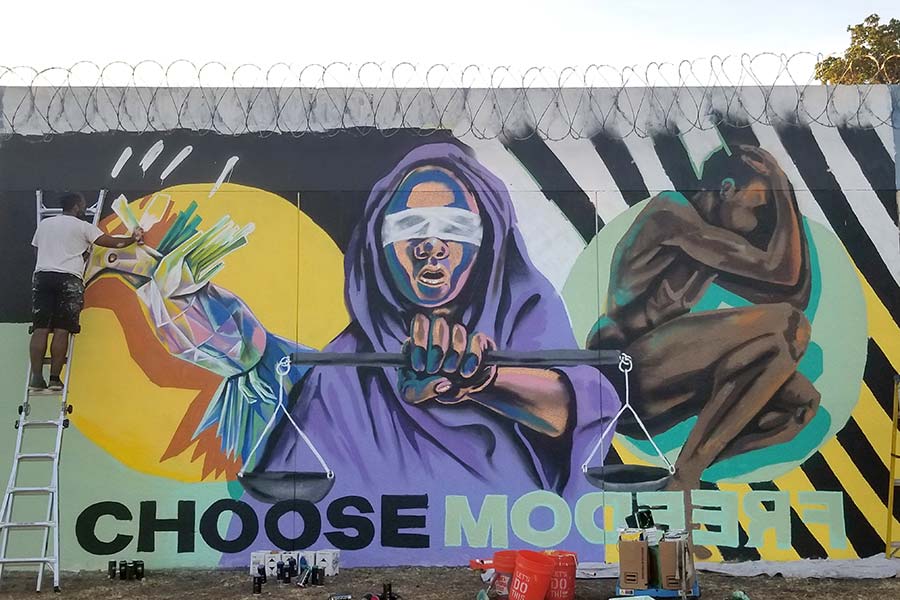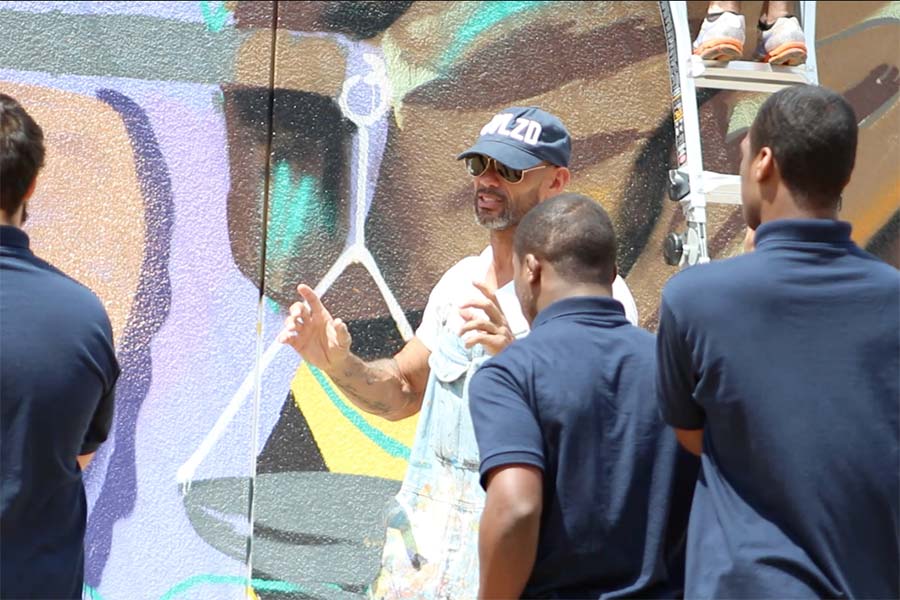Changing the Writing on the Wall
How German Dubois Helps Troubled Teens Escape the Prison of the Mind
German DuBois III has spent most of his adult life devising empathetic and compassionate ways to reach out to those in trouble. Upon graduating from Colgate University in 1991, he accepted a job teaching at Roosevelt High in the Bronx—a school whose truancy rates and reputation for violence at the time had landed it in danger of being closed by the city. However, a new progressive principal was determined to turn the school around, and she gave DuBois a free hand in how to teach his kids so long as they showed up for class.
“I had dropouts coming back to school, kids that had been locked up trying to come back to school,” DuBois remembers. “I had young girls who were either pregnant or just had a baby. I kind of had the cross-section of youth that, in essence, I felt like nobody wanted anymore. Everybody had
pretty much given up on them, and that was my introduction to teaching.” Searching for something to capture the attention of these kids, DuBois hit on the idea of using music. “I would play hip-hop songs in class and then print out the lyrics and get into a discussion about what we thought the artist was trying to convey in their song. Twenty students can listen to lyrics and each will have a different interpretation, which just makes it very powerful. And that kept them engaged. Then that expanded from music into other art forms like poetry and spoken word. It got to the point where it reactivated their interest in learning and it proved to me that all young people want to learn.”
His time at Roosevelt High led DuBois to a career in the educational non-profit world—and eventually to Miami where, in 2017, he experienced another epiphany about the power of art to change hearts and minds. That was the year Hurricane Maria decimated the Caribbean, and in particular, Puerto Rico, leaving thousands dead and tens of thousands homeless, without even potable drinking water. “Being of Puerto Rican descent, I had spent summers there as a child, and I have family and friends that still live on the islands. I was very upset and frustrated. By October the world had seemed to move on and American media had stopped covering the devastation.” Realizing that more awareness of the problem was needed, DuBois lit on the idea of Puerto Rico HOPE, an initiative enlisting local artists to create a series of towering, six-story murals all along a major avenue in the Edgewater neighborhood of Miami.
The murals not only raised awareness and money for those still struggling in Puerto Rico, but they also caught the eye of the warden of Miami Dade Regional Juvenile Detention Center, who approached DuBois with the idea of having his artists paint murals inside the center—the largest in Florida. After a tour of the facility, DuBois remembers, “I said, okay, I’m definitely intrigued, but the teacher in me came out right away and I said, well if I’m going to do anything involving art here, I have to involve the youth who are here.” And that is how Hope Murals, a program that uses street art as a platform to educate at-risk youth, was born. The program aims to build strong dialogue and community values within the walls of the center, based on new ideas and the symbolism the youth see there every day—reaching them in a way that traditional methods typically could not.
Each month, DuBois brings a local guest artist to Miami’s Juvenile Detention Center to meet with five to seven youth incarcerated there. Ranging in age from 9 to 18 years old, they are awaiting an initial court date after arrest—sometimes for an infraction as small as having been accused of lifting a soda from a convenience store. While detention is meant to last only a month, because of the backup in the juvenile courts, a young person might be detained for up to five months at the center before their initial court date.
The Miami-Dade Regional Juvenile Detention Center has a merit system for inmates. Those who keep their records clean as a result of good behavior are eligible to participate in the Hope Murals program at the end of their school day. Over the course of one month these young people, under the direction of DuBois and his artist collaborator, will conceive, plan and execute a mural on the interior walls of the detention center. The first week is dedicated to establishing a real connection with the youth, engaging them in honest conversation that yields strong ideas for the art. One of the guest artists, Black Brain, relates how this first session went down, “We really wanted to get the young men involved in coming up with the mural that we would be painting together. And when we first gathered and spoke together, the concept they kept coming back to was a path once they get out of here—one that leads right back to the detention center, and the other that leads to freedom. It’s up to them to choose that freedom.”
The second week brings everyone together at a section of the interior walls of the facility that the youth vote on themselves, and they begin prepping the wall by scraping paint and applying primer. “While we’re on the wall and they’re working on the wall preparation, I’m asking them questions, like, so, you know, where do you see yourself ten years from now, at age 25? And they’re like, well, I’m not really sure. I don’t know what it’s like to be 25. I’m like, okay, so what advice would you give to your younger self? And they say things like, Oh, I wish you’d just, you know, do better in school or not disrespect my mama, or not be in the street or stop hanging out with these guys. And they say all the things that most adults have probably told them that is part of their challenges.”
After this prep session, the guest artist draws an outline sketch that represents the aspirations of the young participants. The third and fourth sessions will see them filling in the sketch on a paint by numbers basis until the image of the mural emerges bright and colorful in the Florida sunlight.
The detention center management sees it as a great impetus to help the youth they serve to stay positive, stay focused. “When I’m working with the young people in detention, you can literally witness that they come so engaged in what they’re doing on the wall that they forget temporarily that they’re at a juvenile detention center,” DuBois relates. “That’s pretty amazing. And yeah, the whole point of it is to get them to think beyond the bars. You’re physically here, but your mind doesn’t have to be here. And the mind actually needs to be where you want to be because your body will follow where your mind goes.”
The Hope Mural project is nearly three years old now, and there is a waiting list for young inmates to participate. Although restrictions related to the COVID-19 pandemic furloughed the program for some months, DuBois is now making plans to restart again. “Funds provided from Impact Deposits Corp. are greatly appreciated and timely as they directly support the reopening of programming at the JDC. Bill Burdette and the team at the Center for Social Change have been supportive since day one.”











